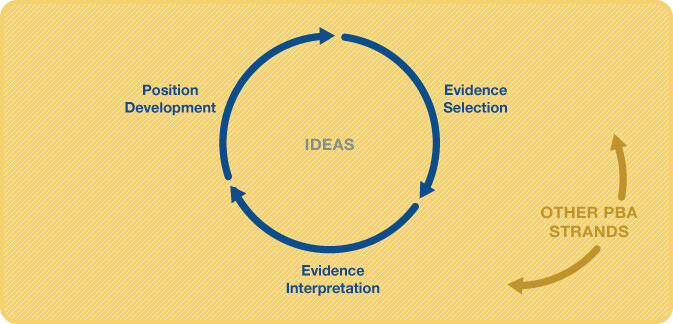How to Use the Achievement First Middle School Writing Rubric to Drive Instruction
The Achievement First Middle School Writing Rubric is a powerful and complex tool to drive excellent instruction. Aligned to the Common Core State Standards and modeled after the Achievement First High School Writing Rubric, it provides a vertical continuum to college and career ready writing. How can teachers use it to drive classroom instruction and units? How can the writing rubric clarify and simplify writing instruction?
While the interactive middle school writing rubric sets a clear vision for excellence and names what excellence looks like, at first glance it can seem a bit overwhelming. In order for teachers to effectively use this tool to drive their instruction, it is important to consider three tenets:
- Cyclical: By design, the Process Based Assessment writing system is cyclical. Teachers cannot and should not teach every strand of the rubric during one essay cycle.
- Depth Over Breadth: Lessons become sticky and writing is mastered when you emphasize depth over breadth in your instruction. It is better to spend one lesson focusing on the difference between a 4 and a 5 in Position than the entire Position row. It is also better to spend more than one day on Position than to jump between multiple strands. Depth over breadth makes learning cohesive and sticky.
- Prioritization: One of the most powerful aspects of the Achievement First Middle School Writing Rubric is its ability to name what students need next. At a whole-class level, teachers can prioritize certain strands and criteria based on scholar need. If scholars are not selecting pertinent evidence yet, it will be futile to focus on interpretation, so a teacher can prioritize evidence selection and save the quality of interpretation for the next cycle. For every scholar, there is a tangible next step to focus (progress goal), regardless of ability. Scholars meeting all of the thresholds from the middle school rubric can be pushed further with strands from the high school rubric. Even though the rubric may seem overwhelming at first, knowing that scholars have multiple at-bats with this type of writing and four years to master these thresholds should free teachers to prioritize what each class and each scholar needs to move to the next tangible step.
While the above are helpful caveats, there is still a lot to consider. In order to simplify the play book, it is helpful to think of writing instruction as a cyclical process rotating through the same three core focus strands: Position, Selection, and Interpretation. This cycle is grounded in Ideas, which is at the heart of all writing and the heart of the Common Core.
The Base of All Writing: IDEAS
The Ideas strand is at the core of this diagram for two reasons:
- Ideas are a product of reading. Strong reading and thinking results in accurate and insightful ideas. Reading is thus the foundation for all academic writing in that it forces scholars into text as they analyze and make claims based on evidence. Students must grapple with complex texts and ideas to generate their own, text-based conclusions. High-quality reading instruction, including the close reading of complex texts, riddled with rigorous text-dependent questions and supported with thoughtfully planned and executed discussions, grounds students in reading, analysis, and ideas.
- Ideas develop when you focus on Position, Selection, and Interpretation. The Ideas strand is not a skill you regularly teach explicitly to the whole class in writing; rather, students’ ideas will grow when you focus on the right things, including grappling with texts. That being said, writing teachers frequently support individual scholars still struggling with the ideas about which they are writing.
The Core Instruction Cycle: Position, Selection, and Interpretation
The above cycle is apparent in reading, thinking, and writing:
- As a reader, one makes an argument about the meaning of a passage (Position), goes back to the text to look for evidence of that meaning (Evidence), then analyzes syntax, word choice, and author’s craft to determine if that original meaning was accurate (Interpretation). A great reader then revises their understanding of the passage (Position), determines the best evidence to support that meaning (Evidence) and develops logical links from evidence to meaning (Interpretation).
- As a thinker, one hypothesizes an argument (Position), collects evidence to support that argument (Evidence) and examines that evidence to clarify meaning (Interpretation). Great thinkers then revise and qualify their argument (Position), re-evaluate the evidence (Evidence) and justify how their evidence supports their argument (Interpretation).
To be clear, one of the most powerful aspects of the Process Based Assessment writing system is its collaborative structure. The prompts and texts that drive the final essay are frequently explicitly taught and discussed in literature, history or science classes, and then move to writing class where the cross-content unit culminates in an expository, thesis-driven essay.
While this Position, Selection, and Interpretation cycle oversimplifies the writing cycle, it provides teachers with a great place to start. After gaining proficiency with the basic cycle, teachers layer on mini-lessons focused on transitions (Organization), active verbs (Word Choice and Sentence Fluency), and appropriate background information (Contextualization), just to name a few.


